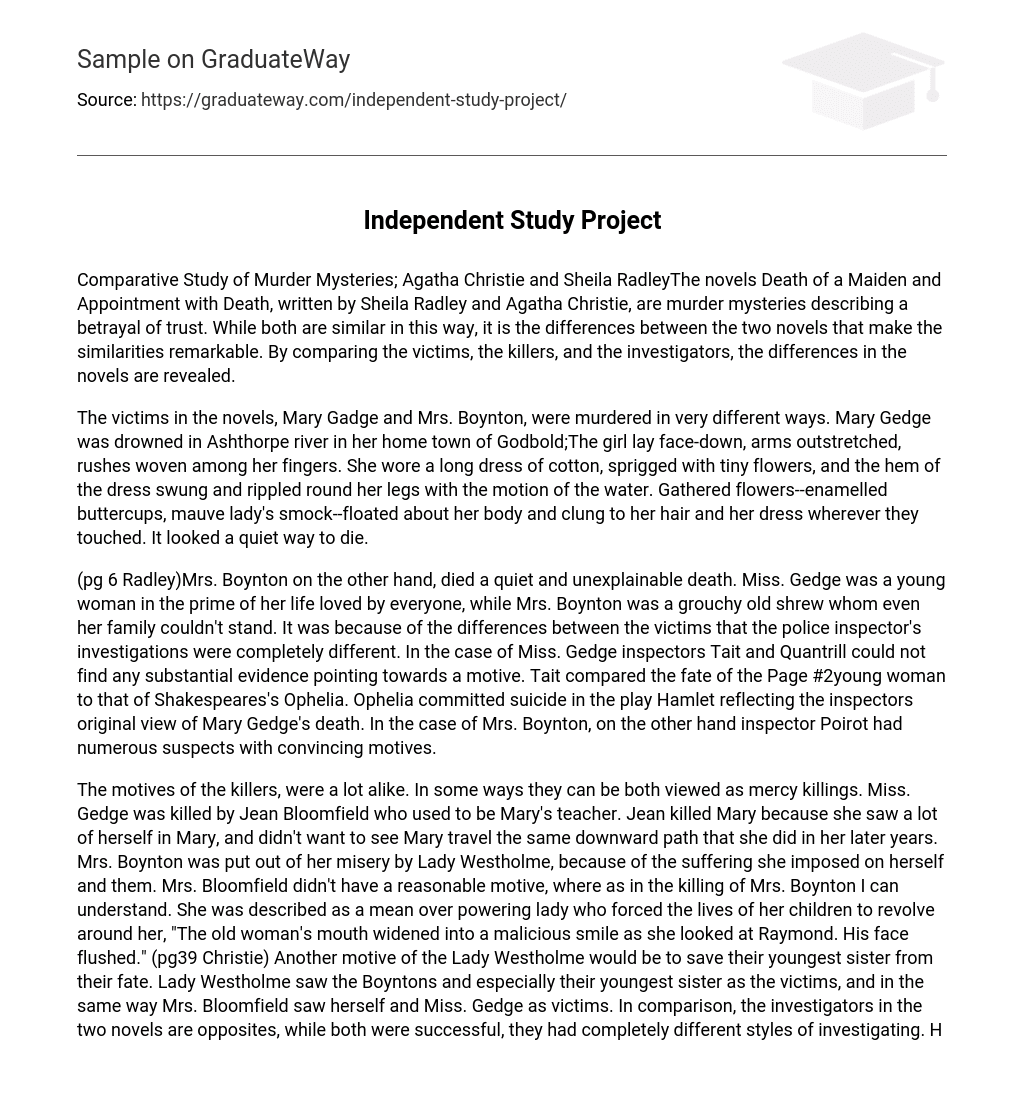Comparative Study of Murder Mysteries; Agatha Christie and Sheila RadleyThe novels Death of a Maiden and Appointment with Death, written by Sheila Radley and Agatha Christie, are murder mysteries describing a betrayal of trust. While both are similar in this way, it is the differences between the two novels that make the similarities remarkable. By comparing the victims, the killers, and the investigators, the differences in the novels are revealed.
The victims in the novels, Mary Gadge and Mrs. Boynton, were murdered in very different ways. Mary Gedge was drowned in Ashthorpe river in her home town of Godbold;The girl lay face-down, arms outstretched, rushes woven among her fingers. She wore a long dress of cotton, sprigged with tiny flowers, and the hem of the dress swung and rippled round her legs with the motion of the water. Gathered flowers–enamelled buttercups, mauve lady’s smock–floated about her body and clung to her hair and her dress wherever they touched. It looked a quiet way to die.
(pg 6 Radley)Mrs. Boynton on the other hand, died a quiet and unexplainable death. Miss. Gedge was a young woman in the prime of her life loved by everyone, while Mrs. Boynton was a grouchy old shrew whom even her family couldn’t stand. It was because of the differences between the victims that the police inspector’s investigations were completely different. In the case of Miss. Gedge inspectors Tait and Quantrill could not find any substantial evidence pointing towards a motive. Tait compared the fate of the Page #2young woman to that of Shakespeares’s Ophelia. Ophelia committed suicide in the play Hamlet reflecting the inspectors original view of Mary Gedge’s death. In the case of Mrs. Boynton, on the other hand inspector Poirot had numerous suspects with convincing motives.
The motives of the killers, were a lot alike. In some ways they can be both viewed as mercy killings. Miss. Gedge was killed by Jean Bloomfield who used to be Mary’s teacher. Jean killed Mary because she saw a lot of herself in Mary, and didn’t want to see Mary travel the same downward path that she did in her later years. Mrs. Boynton was put out of her misery by Lady Westholme, because of the suffering she imposed on herself and them. Mrs. Bloomfield didn’t have a reasonable motive, where as in the killing of Mrs. Boynton I can understand. She was described as a mean over powering lady who forced the lives of her children to revolve around her, “The old woman’s mouth widened into a malicious smile as she looked at Raymond. His face flushed.” (pg39 Christie) Another motive of the Lady Westholme would be to save their youngest sister from their fate. Lady Westholme saw the Boyntons and especially their youngest sister as the victims, and in the same way Mrs. Bloomfield saw herself and Miss. Gedge as victims. In comparison, the investigators in the two novels are opposites, while both were successful, they had completely different styles of investigating. Hercule Poirot was a reoccurring character in all of Christies’ novels. He was a famous investigator who was educated and was well know in the rich community. Inspector Quantrill on the other hand was a hard working man with very little education and money. “It was so bloody unfair. How was he to know who Ophelia was? He’d never had the educational advantages that Tait and the girl and Jean Bloomfield had enjoyed.”(pg Page #398 Radley) He had to work hard for his position, which made his job that much more important to him. His consciousness and his embarrassment about the reference to Ophelia was one of the reasons why he despised Inspector Tait at the beginning of the novel. For inspector Tait was well educated and fairly wealthy, he had an understanding of literature comparable to that of Hercule Poirot’s. In the investigation of the murders Mr. Quantrill had a much harder time finding a murderer than Hercule. Quantrill had to canvas an entire town and interview multiple suspects, where as Hercule had a list of suspects and didn’t have to extend himself much to enquire about the murder. The most interesting similarity between the two books is the way they both quote Hamlet. In the Epilogue of Christies’ novel Sarah Boynton, in the words of Ophelia, whom she is now playing as an actress, describes the fate of her mother, It is rather ironic, I think, that both authors use the words of one of Shakespeare most tragic figures to describe their victims.





